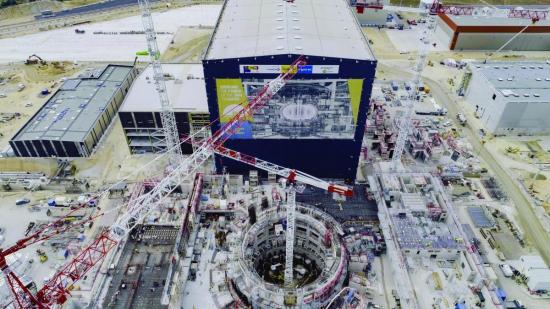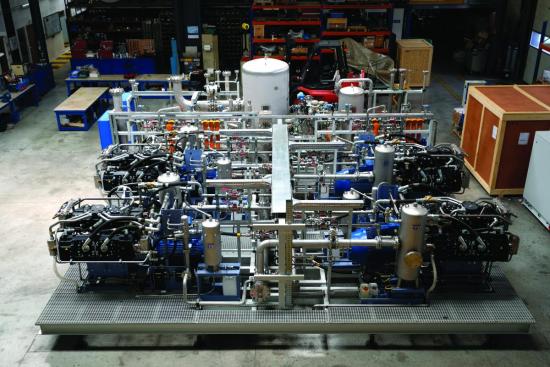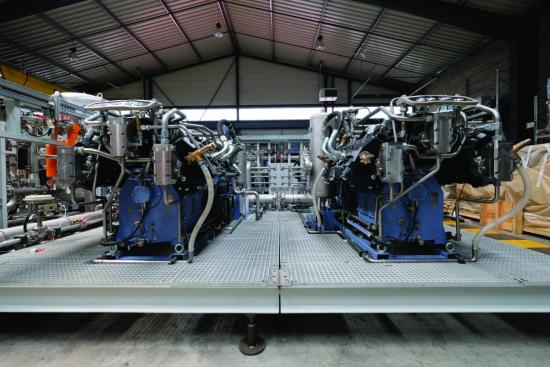A spectacular vision is gradually becoming reality in Cadarache in the south of France. Modeled on the sun, the ITER (International Thermonuclear Experimental Reactor) fusion system uses nuclear fusion to generate energy in order to secure humanity’s supply of electricity. One of the biggest challenges is the high temperature inside the reactor. Technology by Sauer Compressors is a key factor in cooling the reactor. The manufacturer has supplied the world’s largest system for helium recovery.

Aerial view of the ITER construction site. © ITER Organization.
The ITER fusion reactor is an international consortium project involving the European Union, the United States, Russia, China, Japan, South Korea and India. The reactor is scheduled to be put into operation in 2020, with the aim of harnessing nuclear fusion – the sun’s source of energy – under terrestrial conditions as well. The hydrogen isotopes deuterium and lithium melt and form plasma when exposed to immense heat. This process releases large quantities of energy. Researchers hope this will provide an infinite source of energy, one that is entirely emission-free and safe. Proof of concept has been demonstrated. However, up until now heating the plasma to the ignition temperature of around 100 million °C has required a greater input of energy than could be recovered from subsequent fusion.

Cross-section of the ITER fusion reactor. The tokamak has a capacity of 840 m³. © ITER Organization.
The ITER test system has a tokamak-type fusion reactor. At 840 cubic meters its capacity is far greater than other systems of its kind. The reactor is designed to generate ten times the energy needed to ignite the plasma. These immense temperatures prevent the enclosure of fusion plasma in physical vessels. Instead, the system uses gigantic magnetic fields to confine the suspended fuel in thermal insulation and to keep it away from the boundary walls.
Minimizing Helium Consumption
A large volume of highly pressurized helium and an input temperature of 4.5 K are used to cool the superconductive magnetic coils that generate the required magnetic field. However, due to its particular diffusibility the inert gas is a demanding coolant. Helium possesses a very small atomic radius and can pass through even the tiniest openings and pores in metals and screw connections. Since the inert gas is very expensive, loss due to evaporation or leakage must be kept as low as possible. The planners behind the ITER fusion reactor have requested a system to recover the gas that evaporated during the cooling process. An additional system for compressing leakages in the helium loop was to be installed as well.

The fully assembled helium recovery system at the Girodin-Sauer SAS plant. © Sauer Compressors.
Sauer Compressors was the world’s only provider with the ability to meet the project’s demanding requirements. Both systems were manufactured and tested by the Sauer experts in Kiel, Germany. The merging of the two happened at the assembly hall of French company Girodin-Sauer SAS: There, both systems were combined and assembled to form a single unit, consisting of five helium compressors on a four-part base frame measuring 8 x 8 meters – the largest assembly of its kind. The entirely gas-tight recovery system with stainless steel tubing was then dispatched to the customer Air Liquide. Installation on the ITER fusion reactor began in summer 2017.
Special Compressors For Helium Recovery
Once the helium has been used as a coolant, the recovery system collects the gas in 10 storage balloons, each with a capacity of 100 m³. Then four Sauer WP6305 BasSealHe-B helium compressors recompress it. Sauer Compressors developed these compact, two-stage six-cylinder piston compressors as a bespoke solution specifically for this application. They produce a final pressure of 22 bar.g and a volume flow of 535 m³/h with minimal noise and vibration emissions. An integrated water-cooling system enables direct cooling of the cylinders and cylinder valves (single cylinder cooling as well as cooling between the stages). Other features include the unique double shaft seals, the gas-tight safety valves and gas recirculation from the separators.

Sauer Compressors built the WP6305 BasSealHe-B-type helium compressor as a bespoke solution for the ITER application. © Sauer Compressors.
The recovery module will operate in the ITER fusion reactor for around four hours per day and in normal operation will deliver a recompression rate of one gram of helium per second. But the system is designed to compress up to 100 grams of helium per second. This ensures that the complete quantity of helium present in the system can be recovered in case of a blackout of the fusion reactor. This is why the recovery system is the only component that is equipped with an independent emergency power supply.
The compressors have a static leakage rate of less than 0.1 mbar x l/s. Losses are reduced by a factor of 8 compared to optimized air compressors used for the compression of helium. Sauer Compressors determined and validated the machinery’s static and dynamic leakage rates on a special helium test rig under real conditions. All components of the recompression system, including the buffer tanks and the filtration system, were produced by Sauer Compressors.

A PASSAT WP156L BasSealHe-B-type compressor is used to compress leaked gas. © Sauer Compressors.
Compressing Leakage In The Helium Loop
An additional system by Sauer Compressors is used to compress leakages in the helium loop. A special PASSAT WP156L BasSealHe-B-type helium compressor is designed to recompress leakage occurring at mechanical seals in the loop. The three-stage air-cooled piston compressor is built for continuous operation. It achieves a final pressure of 20.5 bar.g and a volume flow of 96 m³/h. With a leakage rate of less than 0.1 mbar x l/s this compressor features an unrivalled gas-tightness.
The installation of the entire helium recovery system will be completed in 2018. The ITER fusion reactor is able to cool the superconductive magnetic coils at minimum helium consumption and therefore keep operating costs permanently low.
About Sauer Compressors
Sauer Compressors is a medium-sized German group of companies with twelve international subsidiaries. The company was founded more than 130 years ago, and has over 80 years experience in compressed air technology. Today, it focuses on the development, production and sale of medium- and high-pressure compressors for applications in the naval, shipping, offshore and industrial sectors. Its modern reciprocating compressors for the compression of air and neutral and inert gases reach pressures of 20 to 500 bar. It offers customized solutions for individual customers, OEMs and companies that operate on a global stage. With a global network of agents and representatives, Sauer maintains close proximity to its customers. By enhancing its range of compressors with high-quality accessories, engineering services, installation and service concepts, Sauer can offer end-to-end system solutions and compressed air modules, including complete turnkey installations.
For more information, visit www.sauerusa.com, www.sauercompressors.com, www.iter.org, www.airliquide.com.
To read similar Air Compressor Technology articles visit www.airbestpractices.com/technology/air-compressors.




